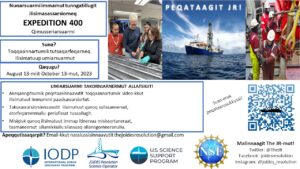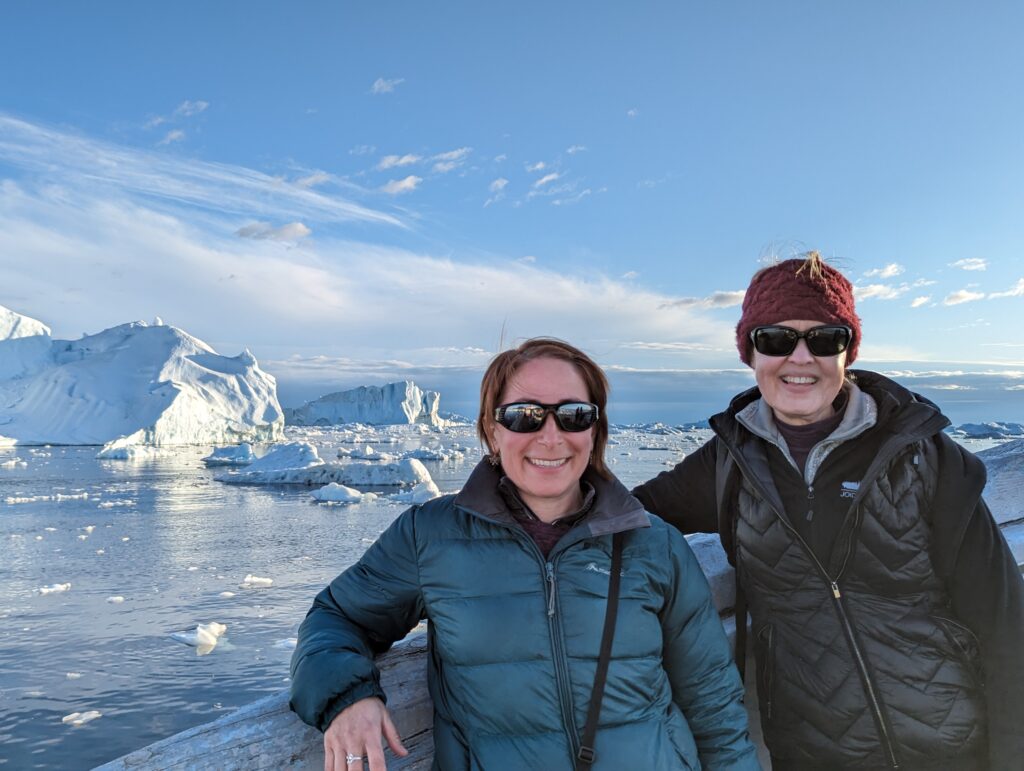
Pre-Expedition Outreach in Denmark and Greenland
Typically, in JOIDES publications we’re sharing exciting science about the ocean floor, core drilling, and significant findings that broaden our understanding of earth science. Many International Ocean Discovery Program (IODP) expeditions aboard the JOIDES Resolution are focused on scientific objectives primarily related to the ocean floor or the earth’s layers below.
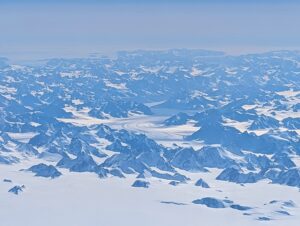
Expedition 400 is one of the unique expeditions with a significant connection to the closest landmass, Greenland! Expedition 400 will be drilling for glacial sediments that used to be on top of the landmass and are now on the ocean floor. How did rock from the top of Greenland end up on the ocean floor? The power of the ice sheet, gravity, glaciers, and lots of time.
The Greenland Ice Sheet is almost 10,000 feet thick in places (almost two miles), and gravity is constantly pulling it downhill and towards Greenland’s coasts. As the ice sheet moves towards the ocean it flows as rivers of ice called glaciers. As glaciers flow across the landscape, they churn and roll just like a river, carving massive mountains into smaller rock and glacial sediments. At the end (toe) of the glacier, huge chunks break off called icebergs. These icebergs float in the ocean, moving with the ocean currents, while also gradually melting and releasing dirt and rocks that settle on the seabed.
In July 2023, Expedition 400 Outreach Officers Beth Doyle @sagasnorth and Michelle Pratt @pursuingseven, traveled to Denmark and Greenland to learn more about Greenlandic people’s connection to the Ice Sheet and experience the glaciers and icebergs that hold sediments which will be an important part of the discoveries to be made on Expedition 400. Here they share their travel experiences.
Denmark
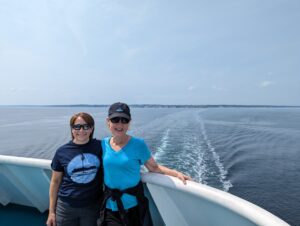
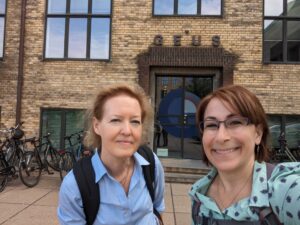
In Denmark, Michelle and Beth were able to meet with officials at the Geological Survey of Denmark and Greenland (GEUS), which is also the home office of Expedition 400 Co-Chief Scientist, Paul Knutz. They did some pre-expedition planning for communications about the expedition and enjoyed the welcoming office environment, complete with a classic local pastry, danishes. They also enjoyed taking in some of the sights of Denmark’s capital city, Copenhagen, and got their first taste of being onboard a ship together during a short ferry ride to explore neighboring Sweden for the day.
Kangerlussuaq, Greenland
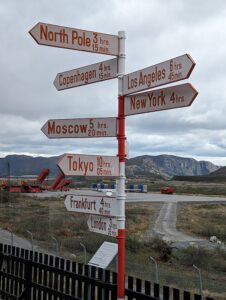
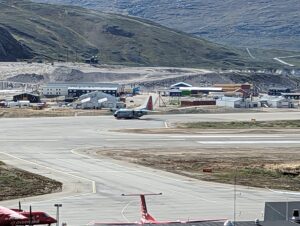
Then on to Greenland! First stop, Kangerlussuaq which is currently the only International Airport in Greenland (though two are under construction in Nuuk and Ilulissat). Kangerlussuaq is a hub of sorts for Greenland, and this includes the science support station for many science operations happening on TOP of the ice sheet, including the United States’ Summit Station and Denmarks’ East Grip. They met with several operations personnel who are also colleagues of Michelle’s from her time in Antarctica, and got a tour of the science support facilities. Kangerlussuaq is one of the warmest places in Greenland, and at least during this time it was also the only place in Greenland they were swarmed by mosquitoes. Today, the huge Greenland Ice Sheet terminates a few miles from town, but historically it covered this whole area and carved the ~120 mile long fjord that connects Kangerlussuaq to the ocean. It was impressive to see from the air flying in, as the approach is directly up the fjord.
Nuuk, Greenland
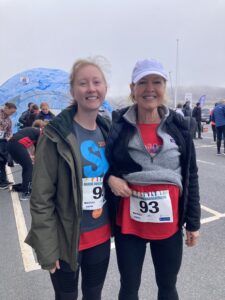
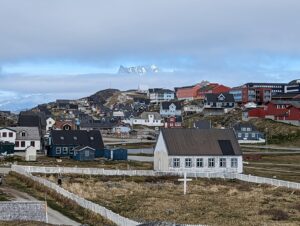
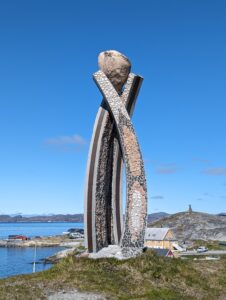
On to the capital city of Nuuk, home to approximately 20,000 Greenlandic people and the largest city in the country of almost 60,000 people. Here, Beth and Michelle met with officials at the Greenland Institute of Natural Resources as well as Arctic Hub, whose mission is to enhance interdisciplinary international cooperation related to Arctic research, education, and innovation in Greenland. As a fun part of the adventure, Beth and her daughter Margaret ran in the Nuuk Half Marathon! This was a fun day to be part of local culture, and following this event Beth and Michelle have also planned a Marathon Around Greenland aboard the JOIDES resolution. This will be a fun event where schools, family, and friends can join the scientists and crew in a virtual race around Greenland during the 2-month expedition. Stay tuned for how to be involved.
The Nuuk skyline is like a postcard – filled with colorful buildings constructed on Greenland’s hard rock, snow capped mountains, glacier-carved fjords, and small arctic flowers clinging to bits of soil dancing in the wind. Dominant in the skyline around Nuuk is Sermitsiaq, an impressive mountain peak whose pointed peaks clearly escaped the erosive forces of the ice sheet and glaciers. How can you tell? Glaciers don’t leave pointed peaks, they smooth and round out all the surfaces as they glide overtop. Up close, you can see the bottom half of the mountain is rounded and shaped by glaciers, but the pointed peaks were preserved and make an impressive skyline over Nuuk today.
Ilulissat, Greenland
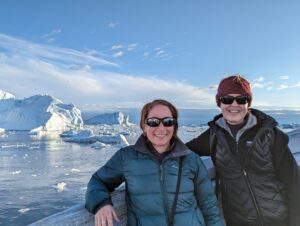

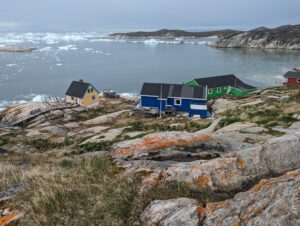
Where Nuuk was important in meeting Greenlandic people and learning more about the history and culture of Greenland, their next destination, Ilulissat, was important in learning about the Greenland Ice Sheet. Located in another of Greenland’s many glacial-carved fjords, Ilulissat is famous for its massive icebergs that float in Disko Bay. The relatively new Ice Fjord Centre has a striking exterior design and impressive interpretation within. Putting on virtual reality goggles, Beth and Michelle were transported on top of the Greenland Ice Sheet to East Grip, Denmark’s scientific research station. There they learned about important scientific research being conducted with another type of core samples – ice cores. It may come as a surprise that the JOIDES’ famous sediment cores from the ocean floor use the same principles as ice cores – drilling to extract samples of material for further scientific study. Both ice cores and sediment cores seek to learn more about Earth’s secrets, locked either in gas bubbles and sediment layers in the ice, or in the layers of sedimentary deposits that have been deposited on the ocean floor by millions of years of glacial processes. Two types of coring technology meet on Expedition 400!
As avid outdoor enthusiasts, Michelle, Beth, and Margaret all agreed that one of the favorite activities they did was a four-hour hike that was easily in their unofficial list of top 10 hikes around the world! From the town of Ilulissat, the hike took them through several dog mushing kennels, which reminded Michelle of home in Alaska. Then post-holing up a chute still filled with spring snow even into July, this is where the hike turned from interesting to amazing as they walked along the edge of the iceberg-filled fjord. Be sure to watch their hiking video of this adventure, pictures and video are definitely worth 1,000 words.
Follow the Expedition
With the foundation laid for Expedition 400, Michelle and Beth are anticipating a successful voyage aboard the JOIDES Resolution. They are excited to join Co-chief scientists Paul Knutz and Anne Jennings, along with a talented group of international science specialists and an experienced crew. As Outreach Officers, Beth and Michelle will be sharing this expedition with you as we all learn more about the secrets of Earth’s past locked in the glacial sediments on the ocean floor in Baffin Bay off the west coast of Greenland.
In addition to all the usual ways to follow JOIDES expeditions, Beth and Michelle have a few extras planned just for Expedition 400. Which of the following interest you?
For Teachers and students:
- If your classroom would like extended lesson coverage and multiple ship-to-shore experiences, consider joining other classrooms in our special collaboration with Reach The World. View the Journey homepage and claim your classroom’s spot by enrolling here.
- We’re still engaging with classrooms through ship-to-shore tours. Learn more about educational resources available and book your live ship-to-shore tour here. We offer times around the clock and have scientists onboard from multiple countries.
For learners and JOIDES enthusiasts of all ages:
- Run/walk/bike/ski a (virtual) marathon with us around Greenland!
- LEGO just released their Arctic Explorer Ship set, woohoo! Watch scientists and crew build the Lego Arctic Explorer ship while ONBOARD a real Arctic Explorer Ship – the JOIDES Resolution.
- A new 360 camera was just purchased, and we will be creating an updated VR/360 tour of the JOIDES. This will be fun!
- Live ship-to-shore tours are available beyond classrooms. We also host tours for museums, science centers, or community organizations, and other groups. Learn more and sign up here. If you have questions, email us at thejoidesresolution@gmail.com

